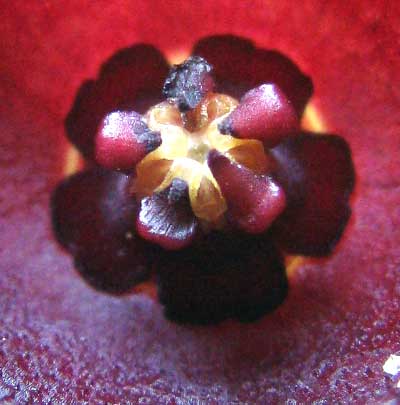Excerpts from Jim Conrad's
Naturalist Newsletter
from the June 6, 2010 Newsletter issued from Hacienda Chichen Resort beside Chichén Itzá Ruins, central Yucatán, MÉXICO; limestone bedrock, elevation ~39m (~128ft), ~N20.676°, ~W88.569°
RED DRAGON FLOWER
About six months ago I got to visit a little Maya village south of Xcalacoop. You just can't get more into the traditional Maya backcountry than that. Therefore, I was surprised when we came into a little village where before one pole-walled, thatch-roofed home there grew a bathtub-size patch of the plant seen below:\
That plant definitely was an alien here. I recognized it as an African member of the Milkweed Family, the very family I collected on an expedition in Madagascar twenty years ago, so it was even more of a special finding for me. How on earth did this African plant ever find its way into such an isolated corner of the Yucatán?
My friend Ulli at the University of Bayreuth in Germany, who specializes in the family, steered me toward the name HUERNIA SCHNEIDERANA, sometimes known as the Red Dragon Flower, cautioning that these plants have been under cultivation as ornamentals for so long that I may have a hybrid or something like that.
In the genus Huernia this species, schneiderana, is recognized as having one of the smallest and least interesting flowers of the genus, but the plant itself thrives under cultivation, so it's a favorite among gardeners looking for something exotic looking but easy to grow. Most people assume that it's a cactus, though of course cacti are in the Cactus Family, not the Milkweed Family, and have completely different flowers and fruits. The spines mantling the plants are so soft that you wonder how they provide any protection at all. As you might expect of a member of the Milkweed Family, fresh wounds issue copious juice, not the usual white in this case, but clear or greenish and mucilaginous.
When the lady of the house where we found the plant saw our interest she generously gave us a handful of stems -- for stems they are, no leaves being visible in the picture. On the Internet I read that the Konso peoples of southwestern Ethiopia cultivate this plant on rock walls of their terraced fields, to serve as a famine food if the regular crops fail, so I stuck most of the stems in cracks of our parking lot's stone wall. Now six months later the stems have rooted, budded new stems and seem set to produce interesting colonies later on. Unfortunately, those stems planted too close to the wall's top have been chopped off by foraging Black Iguanas who don't seem to notice the soft spines.
In the above picture you may have noticed the little maroon-colored flower at the lower left. A close-up is below:

An even closer look at the sexual parts is seen below:

That last image should convince anyone knowing their milkweed flower anatomy that Huernias are genuine milkweeds. You can review milkweed flower anatomy at www.backyardnature.net/fl_milkw.htm.